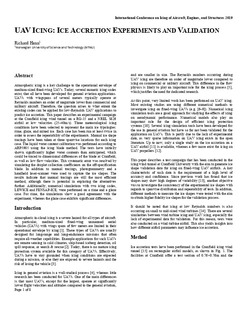| dc.description.abstract | Atmospheric icing is a key challenge to the operational envelope of medium-sized fixed-wing UAVs. Today, several numeric icing codes exist, that all have been developed for general aviation applications. UAVs with wingspans of several meters typically operate at Reynolds numbers an order of magnitude lower than commercial and military aircraft. Therefore, the question arises to what extent the existing codes can be applied for low-Reynolds UAV applications to predict ice accretion. This paper describes an experimental campaign at the Cranfield icing wind tunnel on a RG-15 and a NREL S826 airfoil at low velocities (25-40m/s). Three meteorological icing conditions have been selected to represent the main ice typologies: rime, glaze, and mixed ice. Each case has been run at least twice in order to assess the repeatability of the experiments. Manual ice shape tracings have been taken at three spanwise locations for each icing case. The liquid water content calibration was performed according to ARP5905 using the icing blade method. The tests have initially shown significantly higher water contents than anticipated, which could be traced to dimensional differences of the blade at Cranfield, as well as low flow velocities. This systematic error was resolved by simulating the droplet collection coefficients on the off-specification blade. In addition to manual tracings, photogrammetry and a handheld laser-scanner were used to capture the ice shapes. The results indicate that manual tracings are still the most efficient method, although there is potential in exploring the alternatives further. Additionally, numerical simulations with two icing codes, LEWICE and FENSAP-ICE, were performed on a rime and a glaze case. For rime, the simulations show a good agreement with the experiment, whereas the glaze case exhibits significant differences | nb_NO |
